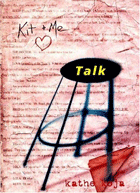 Ronald L. Donaghe reviews the Young Adult novel
Ronald L. Donaghe reviews the Young Adult novelTalk
by Kathe Koja
 Talk
Talkby Kathe Koja
Francis Foster Books
Farrar, Straus and Giroux
www.fsgkidsbooks.com
Hardback, 134 pages, $16.00
Kathe Koja is the author of The Blue Mirror, Buddha Boy, and Straydog. She lives in the Detroit area with her husband and son.
At certain times in my life, it seems that I've experienced a series of events or run across a grouping of similar thoughts within the span of just a few weeks or a month. This time, it has been on the issue (and closely related themes) of bullying in our public schools. Earlier in the month of April, I happened onto an article on some website, where the president of a newly formed group in Florida calling itself "The Bully Police" had answered some questions, like "why don't you mention gay people when talking about bullying in the public schools?" The president of this group answered that bullying affects ALL children and to single out a particular group was to somehow trivialize the issue for the rest of the children. You know, I wasn't satisfied with the answer, so I wrote to the president of The Bully Police and related how I thought that because of gay/lesbian people's relative invisibility in society—even in high school—that NOT to single them out, or at least mention them as a group that is often bullied, was to allow people not to think of gay and lesbian children when they thought of bullying. And yet, the president of this organization wrote me back a disarmingly friendly letter. She saw my point and reiterated her own. Since then, I learned from her that there are those very close to her who are gay and that she was being sensitive to their needs NOT to be identified.
That was one event in this event cluster. Jerry Flack in this issue reviews a book titled Hear Me Out, which in part discusses bullying through the voices of the children. And there have been other instances of the subject of bullying that I've encountered recently.
So, what about Talk? It's not about bullying, really, but it can be applied to the psychological effect that bullying (or the strong against the weak) has on children. Talk is a well executed novel of a play within a play of two main characters who are chosen as the leads in a play being produced by the high school drama department. The lead female, Lindsay Walsh, is a popular student, beautiful, and talented. The lead male, Kit Webster, is an invisible student, until he begins to get his footing in the play and also catches the attention outside of the play by Lindsay. What we get is parallel action, as within any good play within a play, where the real life of the characters is in some ways mirrored by the play they are performing. In this instance, we have an invisible gay male (Kit) in school becoming a "bully" in the play as his character interrogates a terrorism suspect—the popular female student, Lindsay. Their interaction in the play is informed by what they bring to it from their real lives. And what we see of their real lives is almost total dialog, as if they are merely play-acting in real life. We also get interior monolog from Kit and Lindsay as the story progresses. We learn that Kit has a mad crush on an out-of-reach male student. We learn that Lindsay is often terrified and tired of being popular. She has plenty of problems in her real life, not the least of which is being a girl friend to a boorish male student.
It turns out that the play itself is controversial and so the parents pressure the school to shut the play down (the strong against the weak). So when the two lead actors in the play decide that it's too important to let the play be shut down, they find the strength and courage inside themselves to stand up to the "bullies." This is also a story about "us" against "them," "me" against "you." It is a coming out story, and a story of self-acceptance. But to say more about the plot is to give too much away in this short novel.
I admit, it does take a little getting used to the clammoring of voices, almost as if the reader is hearing them in a chaotic way. The reader gets play dialog, interior monolog, and character dialog without a smooth transition from one to the other. In a different writer's hands, the writer might have said: "Okay, this is so and so talking, now this is this character thinking, now talking, now reciting lines." But after awhile, the reader gets the rhythm of the story without such direction. In fact, I think young adults will find the fast pace of the story and all its voices to be easy to read and absorb. I give it a hearty four stars.